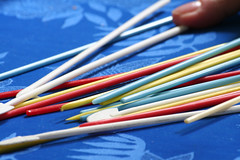It sounds like a simple game. Pick up the most sticks, and you win. But there’s a twist, and the twist makes the game a perfect metaphor for how to approach your “next action” list. You see, all the different-colored sticks have different point values. And a few of the sticks are worth more than all the others combined. So the number of sticks you end up with actually means a lot less than does the value of the sticks you successfully pick up. My sons (ages 7 and 5) are competitive, and the first time they played pick-up sticks, they immediately “got it.” After I dropped the 33 sticks in a pile, they went right after the three blue sticks (worth 400 points) and the sole black stick (worth 1,000 points), even though there were sixteen yellow sticks (2 points), eight red sticks (4 points), and five green sticks (40 points) that were easier to grab. Their strategy was simple and effective: go after the big fish first; get those blue and black sticks; score the most points; win! Neither of my sons is a genius, yet both of them understand intuitively that victory depends upon snagging the scarce blue and black sticks first. And achievement principles are devilishly similar. In our own game of “pick-up sticks” (where the sticks are “next actions” on our daily to-do lists), we are seduced by the temptation to spend time and energy trying to pick up numerous yellow and red sticks. We find it’s easier to stay busy with the yellows and reds and it feels good to be successful over and over again, even though “winning” might actually require completing a single, challenging, important next-action and not necessarily completing lots of next actions. Following through on a single important phone call at 8:45am is often worth more than all the emails, meetings, and calls that are made the rest of the day! Of course, all of us do need to “pick-up” the yellows and the reds on our next action lists when we’re in the right context to do so. These represent commitments that must be fulfilled, regardless of their apparent “point values.” However, we must learn from the way my two young sons play pick-up sticks and remember that, in the end, winning the game of achievement hinges on identifying and “picking-up” the blue and black sticks on your next action list, not putting them off until another day in favor of the busy-trap’s yellows and reds. Rob Crawford, a school administrator who loves baseball and acoustic guitars, writes on productivity, impact, and happiness at Crawdaddy Cove.
